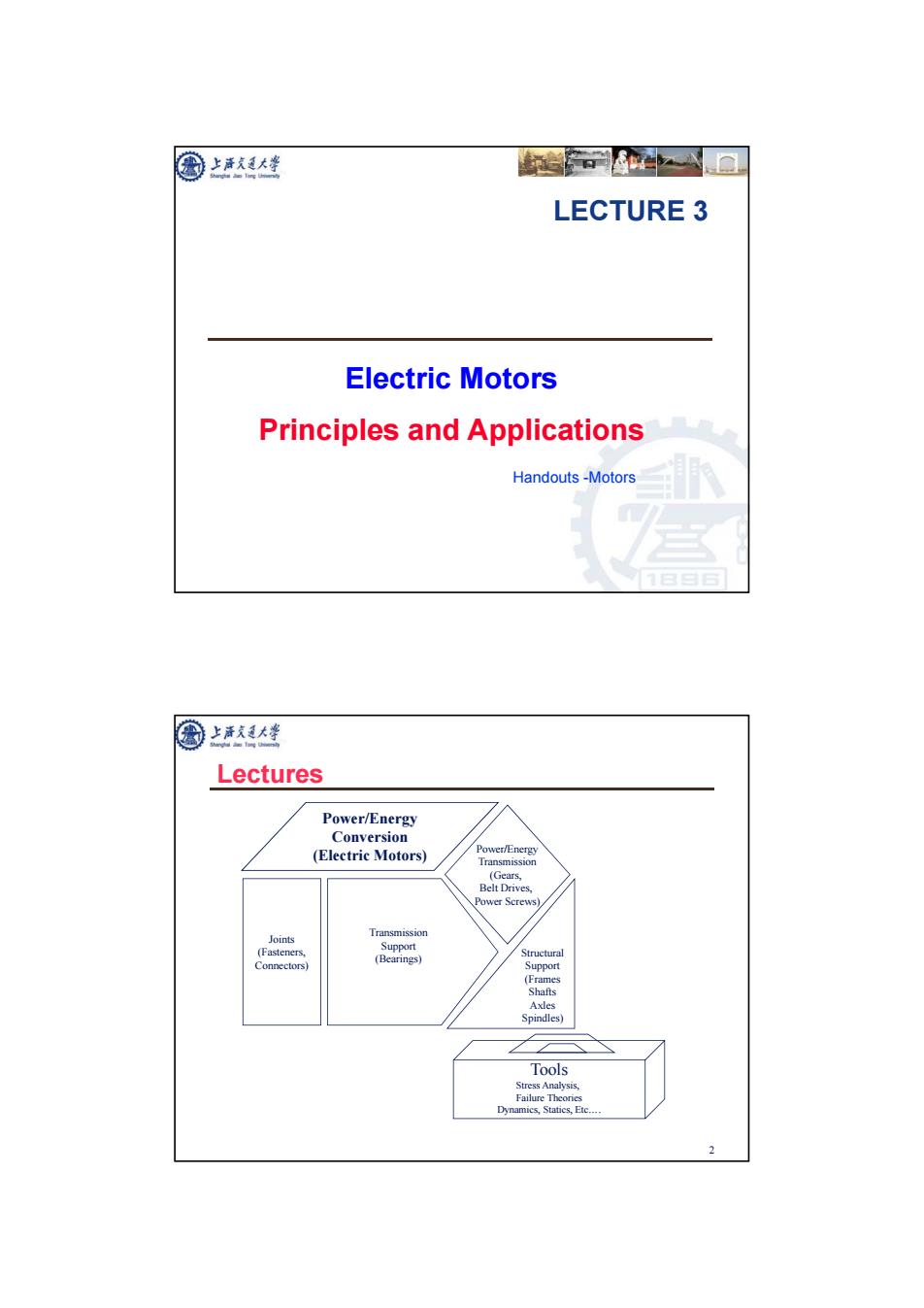
国上清大逢 LECTURE 3 Electric Motors Principles and Applications Handouts-Motors 圈上式人生 Lectures Power/Energy Conversion (Electric Motors) Power/Energy Transmission (Gears, Belt Drives, Power Screws) Joints Transmission (Fasteners, Support Structural Connectors) (Bearings) Support (Frames Shafts Axles Spindles) Tools Stress Analysis, Failure Theories Dynamics,Statics,Ete. 2
1 Electric Motors Principles and Applications Handouts -Motors LECTURE 3 2 Lectures Power/Energy Conversion (Electric Motors) Power/Energy Transmission (Gears, Belt Drives, Power Screws) Transmission Support (Bearings) Joints (Fasteners, Connectors) Structural Support (Frames Shafts Axles Spindles) Tools Stress Analysis, Failure Theories Dynamics, Statics, Etc…
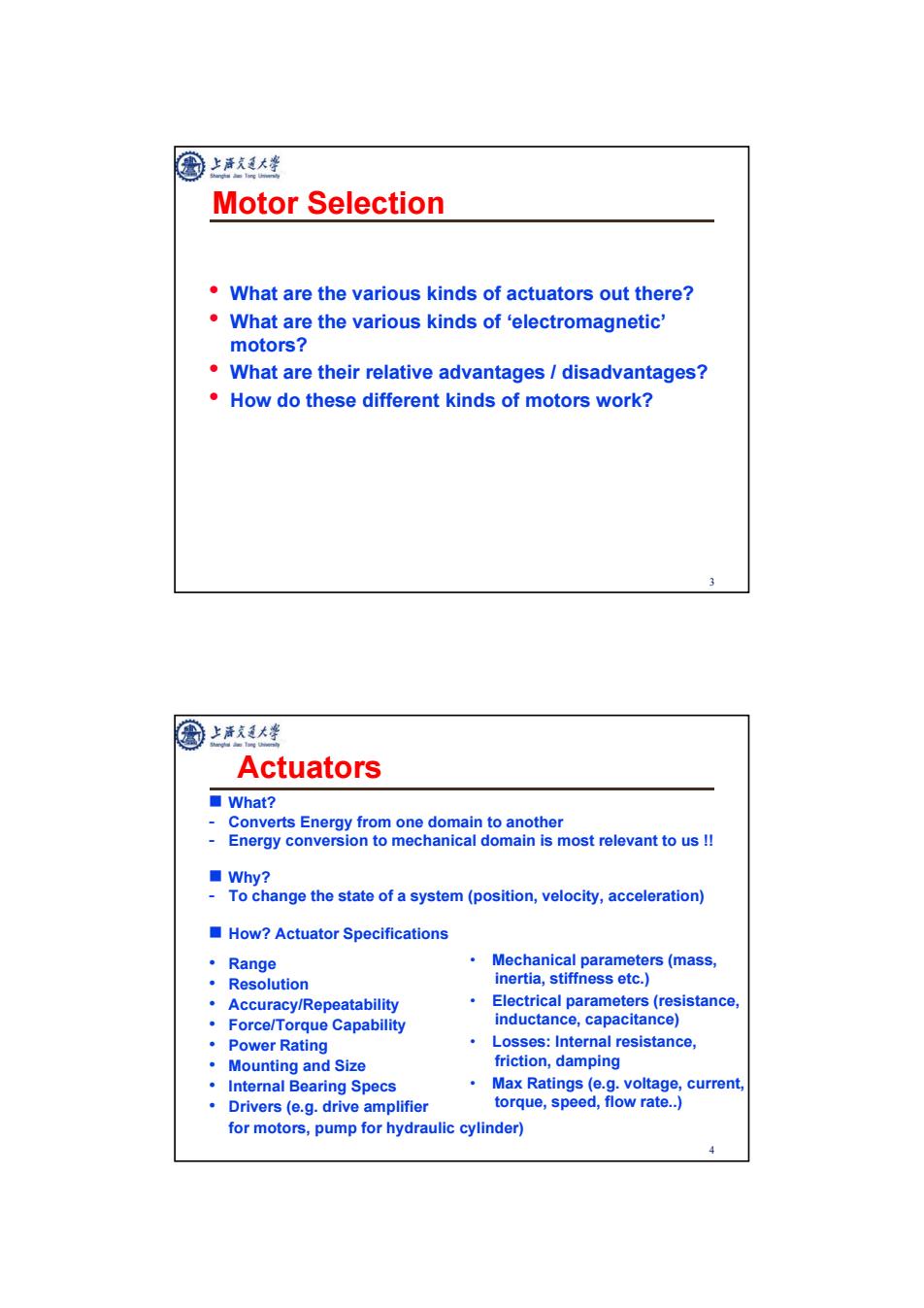
国上活廷大学 Motor Selection What are the various kinds of actuators out there? What are the various kinds of 'electromagnetic' motors? What are their relative advantages/disadvantages? How do these different kinds of motors work? Actuators ■What? Converts Energy from one domain to another Energy conversion to mechanical domain is most relevant to us ! ■Why? To change the state of a system(position,velocity,acceleration) How?Actuator Specifications ·Range Mechanical parameters(mass, Resolution inertia,stiffness etc.) Accuracy/Repeatability Electrical parameters(resistance, Force/Torque Capability inductance,capacitance) Power Rating Losses:Internal resistance, Mounting and Size friction,damping Internal Bearing Specs Max Ratings (e.g.voltage,current, Drivers(e.g.drive amplifier torque,speed,flow rate..) for motors,pump for hydraulic cylinder)
3 Motor Selection • What are the various kinds of actuators out there? • What are the various kinds of ‘electromagnetic’ motors? • What are their relative advantages / disadvantages? • How do these different kinds of motors work? 4 Actuators What? - Converts Energy from one domain to another - Energy conversion to mechanical domain is most relevant to us !! Why? - To change the state of a system (position, velocity, acceleration) How? Actuator Specifications • Range • Resolution • Accuracy/Repeatability • Force/Torque Capability • Power Rating • Mounting and Size • Internal Bearing Specs • Drivers (e.g. drive amplifier for motors, pump for hydraulic cylinder) • Mechanical parameters (mass, inertia, stiffness etc.) • Electrical parameters (resistance, inductance, capacitance) • Losses: Internal resistance, friction, damping • Max Ratings (e.g. voltage, current, torque, speed, flow rate..)
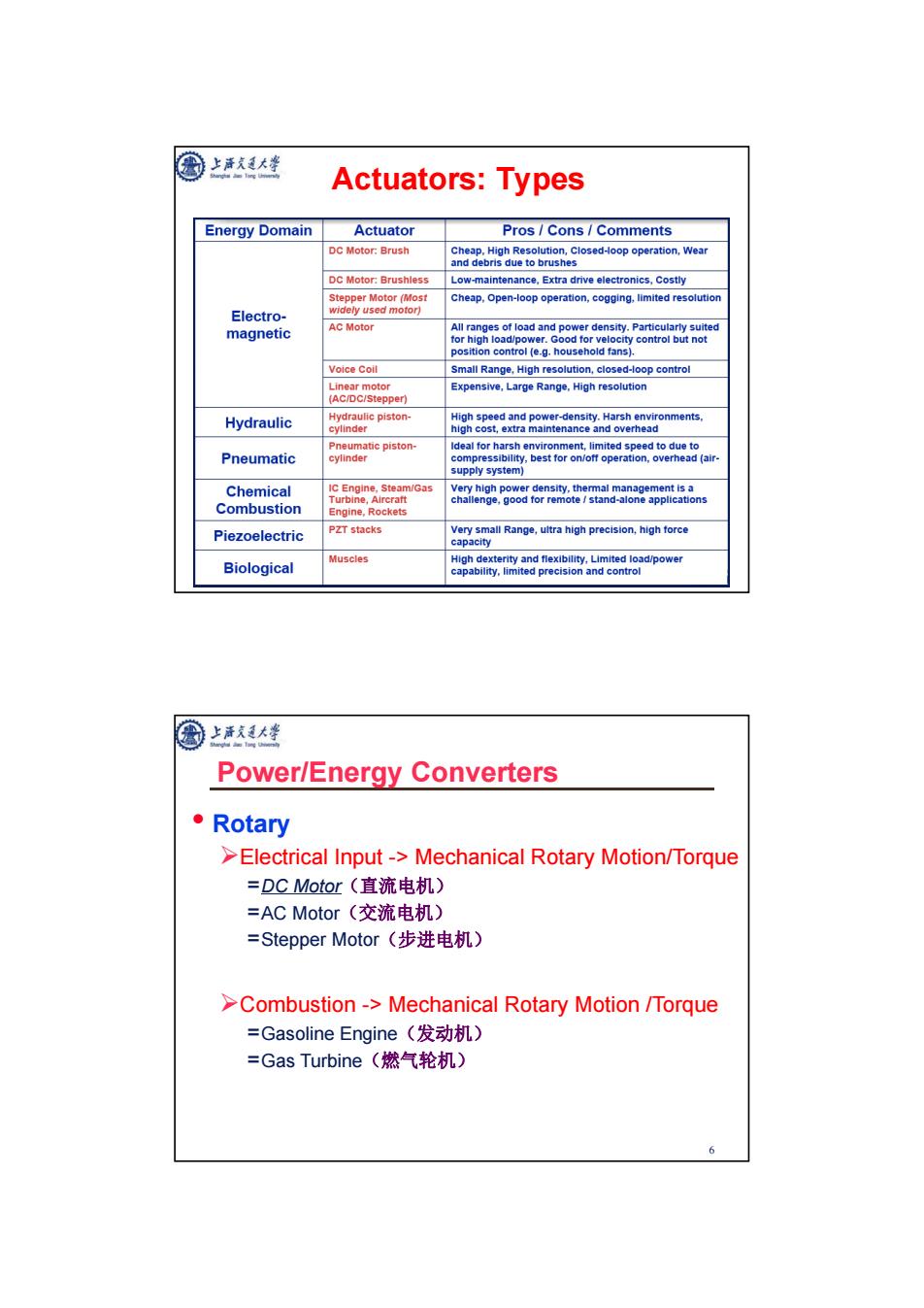
圈上活大峰 Actuators:Types Energy Domain Actuator Pros/Cons /Comments DC Motor:Brush Cheap,High Resolution,Closed-loop operation,Wear and debris due to brushes DC Motor:Brushless Low-maintenance,Extra drive electronics,Costly Stepper Motor(Most Cheap,Open-loop operation,cogging,limited resolution Electro- widely used motor) magnetic AC Motor All ranges of load and power density.Particularly suited tor high load/power.Good for velocity control but not position control (e.g.household fans). Voice Coil Small Range,High resolution,closed-loop control Linear motor Expensive,Large Range,High resolution (AC/DC/Stepper) Hydraulic Hydraulic piston- High speed and power-density.Harsh environments, cylinder high cost,extra maintenance and overhead Pneumatic piston- deal for harsh environment,limited speed to due to Pneumatic cylinder compressibility,best for on/off operation,overhead(air- supply system) Chemical IC Engine,Steam/Gas Combustion Turbine, Engine,Rockets Piezoelectric PZT stacks Very small Range,ultra high precision,high force capacity Biological Muscles High dexterity and flexibility.Limited load/power capability,limited precision and control 圈活大娃 Power/Energy Converters ●Rotary >Electrical Input->Mechanical Rotary Motion/Torque =DC Motor(直流电机) =AC Motor(交流电机) =Stepper Motor(步进电机) >Combustion->Mechanical Rotary Motion /Torque =Gasoline Engine(发动机) =Gas Turbine(燃气轮机) 6
5 Actuators: Types 6 Power/Energy Converters • Rotary Electrical Input -> Mechanical Rotary Motion/Torque =DC Motor(直流电机) =AC Motor(交流电机) =Stepper Motor(步进电机) Combustion -> Mechanical Rotary Motion /Torque =Gasoline Engine(发动机) =Gas Turbine(燃气轮机)
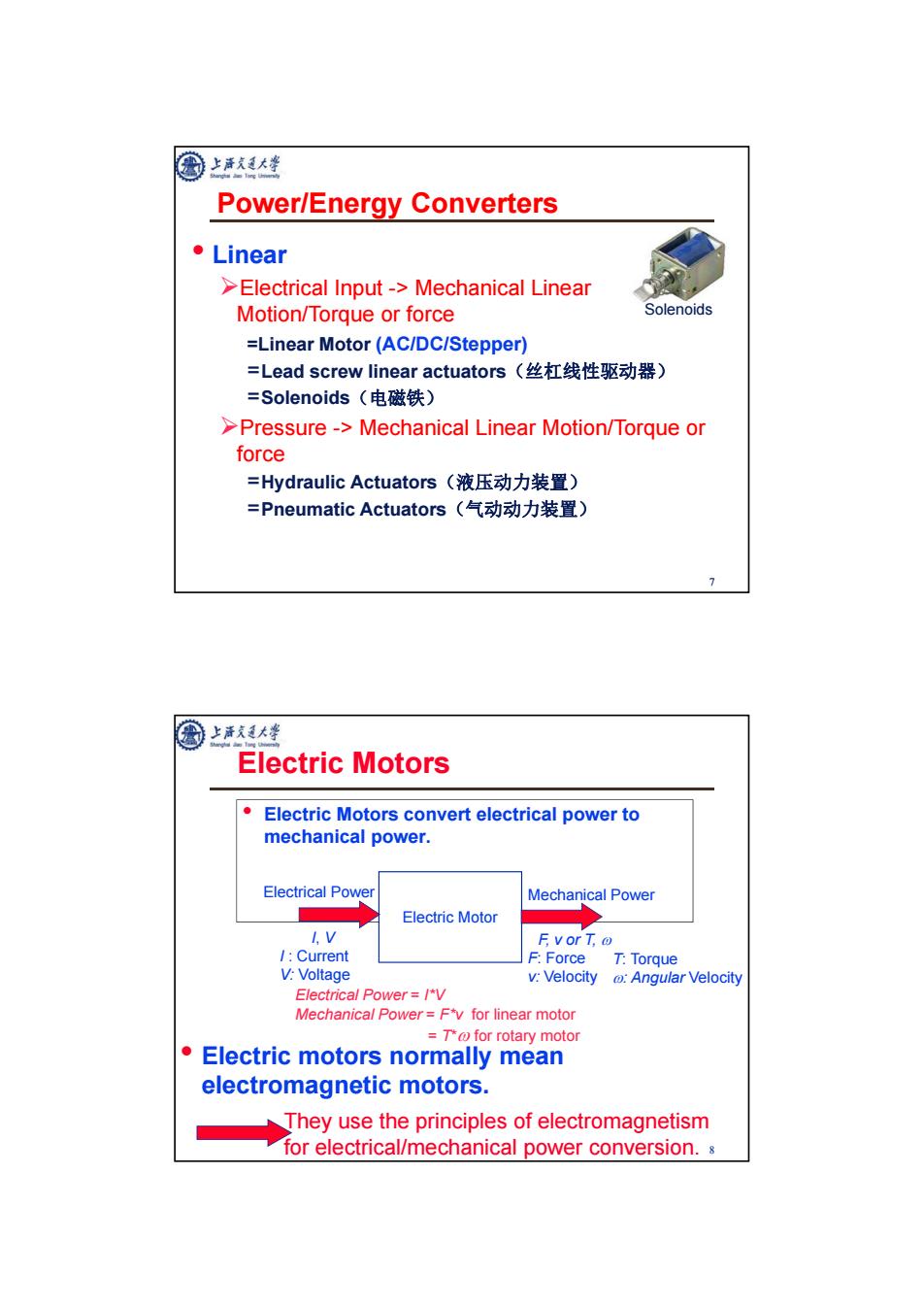
Power/Energy Converters 。Linear >Electrical Input->Mechanical Linear Motion/Torque or force Solenoids =Linear Motor(AC/DC/Stepper) =Lead screw linear actuators(丝杠线性驱动器) =Solenoids(电磁铁) >Pressure->Mechanical Linear Motion/Torque or force =Hydraulic Actuators(液压动力装置) =Pneumatic Actuators(气动动力装置) 上泽充通大学 Electric Motors Electric Motors convert electrical power to mechanical power. Electrical Power Mechanical Power Electric Motor IV F vor T. /Current F:Force T:Torque V:Voltage v:Velocity Angular Velocity Electrical Power=IV Mechanical Power=F*v for linear motor =To for rotary motor Electric motors normally mean electromagnetic motors. They use the principles of electromagnetism for electrical/mechanical power conversion.s
7 Power/Energy Converters • Linear Electrical Input -> Mechanical Linear Motion/Torque or force =Linear Motor (AC/DC/Stepper) =Lead screw linear actuators(丝杠线性驱动器) =Solenoids(电磁铁) Pressure -> Mechanical Linear Motion/Torque or force =Hydraulic Actuators(液压动力装置) =Pneumatic Actuators(气动动力装置) Solenoids 8 Electric Motors • Electric Motors convert electrical power to mechanical power. Electric Motor Electrical Power I, V Mechanical Power F, v or T, I : Current V: Voltage F: Force v: Velocity T: Torque : Angular Velocity • Electric motors normally mean electromagnetic motors. They use the principles of electromagnetism for electrical/mechanical power conversion. Electrical Power = I*V Mechanical Power = F*v for linear motor = T* for rotary motor
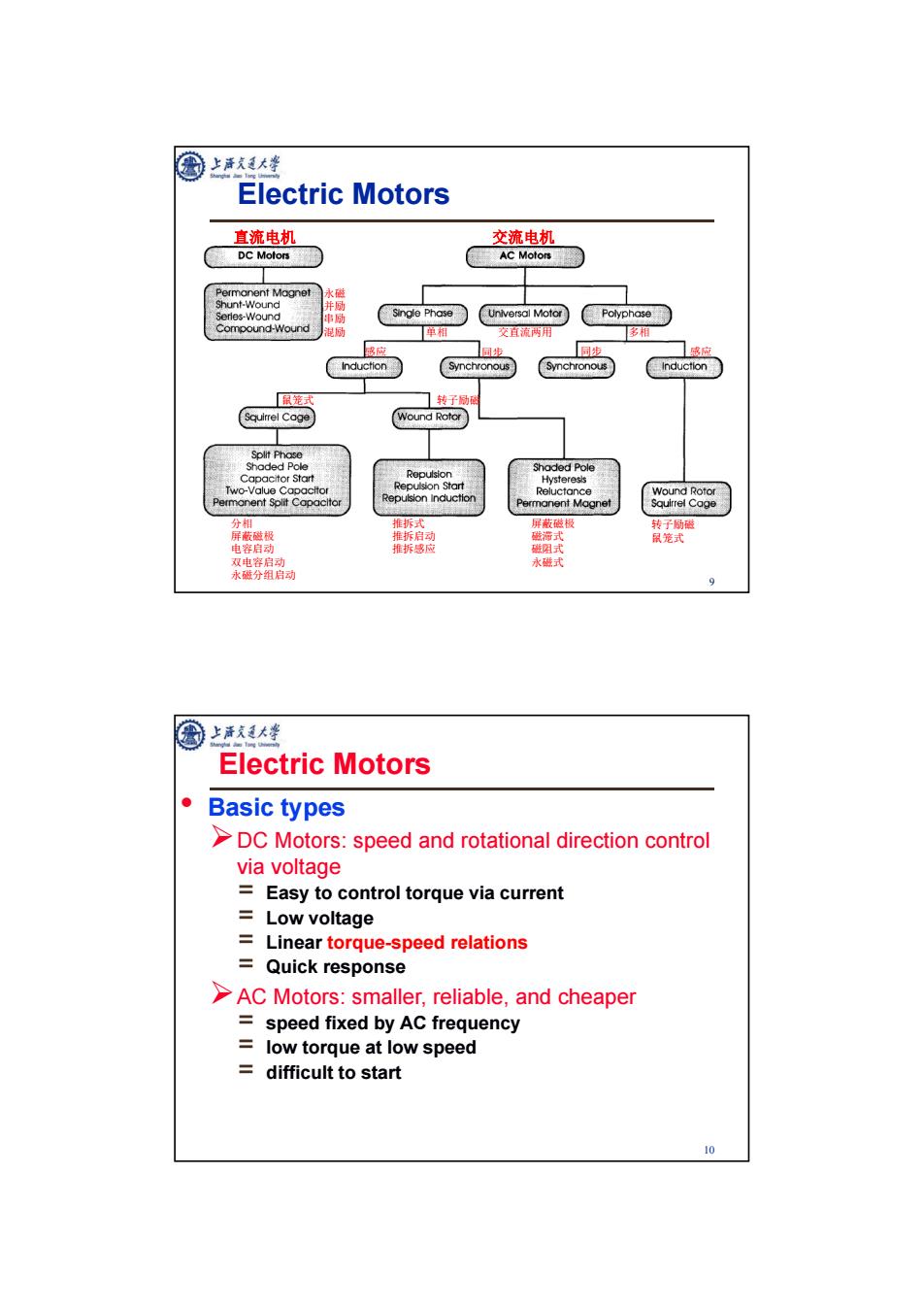
Electric Motors 直流电机 交流电机 DC Molors 水磁 Shunt-Wound 并励 Series-Wound 串励 Single Phase Universal Motor Polyphase Compound-Wound 励 单相 交直流两用 多相 应 同步 同步 成应 Induction Synchronous Synchronous Induction 鼠笼式 ☐转子励 Squirrel Cage Wound Rotor Split Phase Shaded Pole Repulsion Shaded Pole Capacitor Start Repulsion Start Hysteresis Two-Value Capacltor Repulsion Induction Reluctance Wound Rotor Permanent Split Capacitor Permanent Magnet Squirrel Cage 分相 推拆式 屏蔽磁极 转子励磁 屏蔽磁极 推拆启动 带蓝式 佩笼式 电容启动 推拆感应 碰阻式 双电容启动 永碰式 永磁分组启动 图 上清我通大学 Electric Motors Basic types >DC Motors:speed and rotational direction control via voltage Easy to control torque via current =Low voltage Linear torque-speed relations =Quick response >AC Motors:smaller,reliable,and cheaper 三 speed fixed by AC frequency low torque at low speed difficult to start 公
9 Electric Motors 直流电机 交流电机 永磁 并励 串励 混励 单相 交直流两用 多相 感应 同步 同步 感应 鼠笼式 转子励磁 分相 屏蔽磁极 电容启动 双电容启动 永磁分组启动 推拆式 推拆启动 推拆感应 屏蔽磁极 磁滞式 磁阻式 永磁式 转子励磁 鼠笼式 10 • Basic types DC Motors: speed and rotational direction control via voltage = Easy to control torque via current = Low voltage = Linear torque-speed relations = Quick response AC Motors: smaller, reliable, and cheaper = speed fixed by AC frequency = low torque at low speed = difficult to start Electric Motors
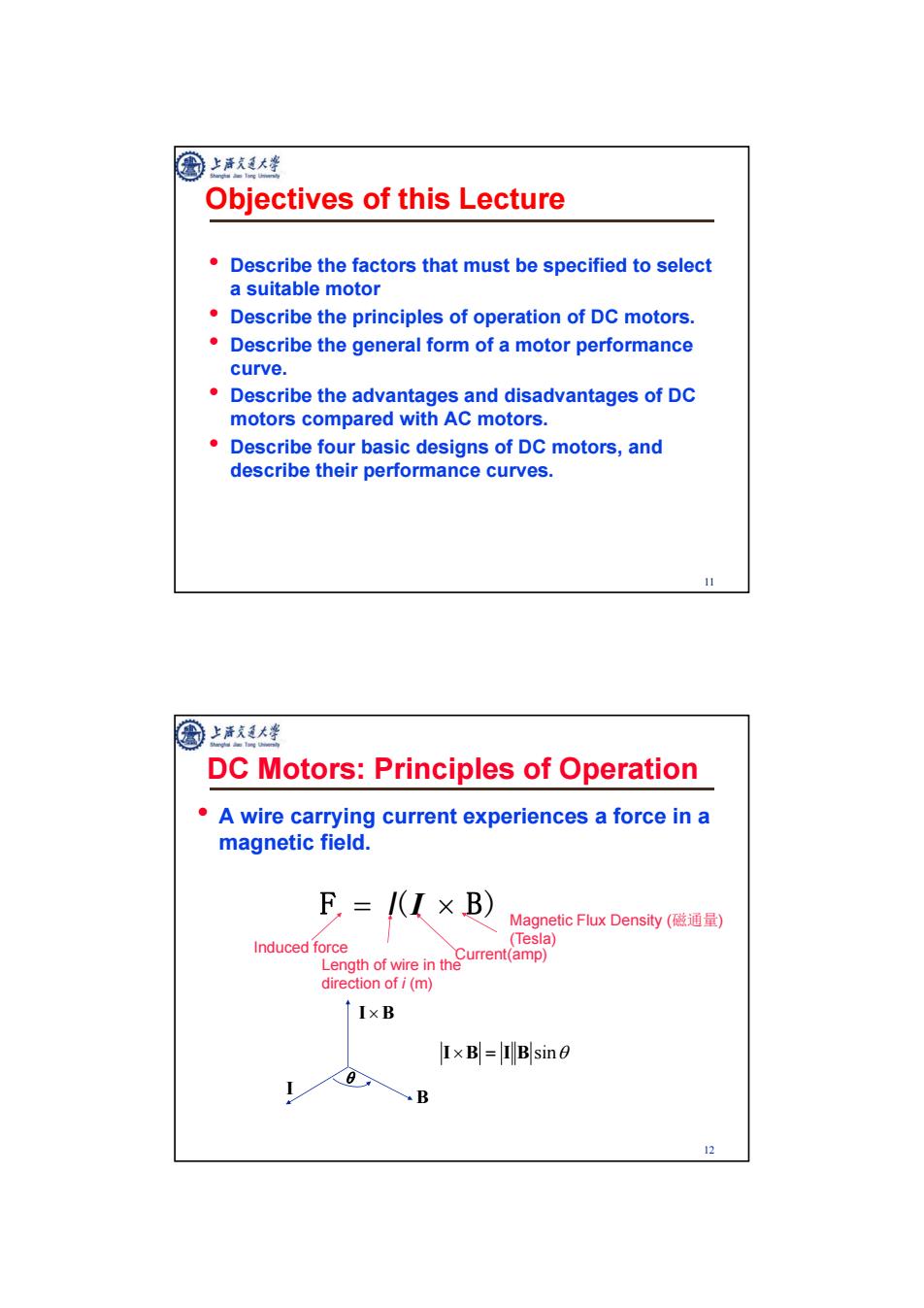
国上活廷大学 Objectives of this Lecture Describe the factors that must be specified to select a suitable motor Describe the principles of operation of DC motors. Describe the general form of a motor performance curve. Describe the advantages and disadvantages of DC motors compared with AC motors. Describe four basic designs of DC motors,and describe their performance curves. 11 国我人峰 DC Motors:Principles of Operation A wire carrying current experiences a force in a magnetic field. F= /(I×B) Magnetic Flux Density(磁通量) (Tesla) Induced force urrent(amp) Length of wire in the direction of i(m) ↑I×B IxB=IBsin B 々
11 Objectives of this Lecture • Describe the factors that must be specified to select a suitable motor • Describe the principles of operation of DC motors. • Describe the general form of a motor performance curve. • Describe the advantages and disadvantages of DC motors compared with AC motors. • Describe four basic designs of DC motors, and describe their performance curves. 12 DC Motors: Principles of Operation • A wire carrying current experiences a force in a magnetic field. Magnetic Flux Density (磁通量) (Tesla) F l(I B) Induced force Current(amp) Length of wire in the direction of i (m) I B I B IB I B sin

Electromagnetic Force A wire carrying current in a magnetic field. B F=ilB (/wire length) Note:a dot will represent a current out of the page and a cross(x)will represent a current into the page. 3 国 上清我通大学 DC Motor Operation Current runs through conductor >Armature winding(电枢绕组) Winding placed in magnetic field >Generates a force =Causes it to rotate Brushes (stationary)
13 Electromagnetic Force • A wire carrying current in a magnetic field. B i F = ilB (l = wire length) Note: a dot will represent a current out of the page and a cross() will represent a current into the page. 14 DC Motor Operation • Current runs through conductor Armature winding(电枢绕组) • Winding placed in magnetic field Generates a force =Causes it to rotate

圈上海夫廷大烽 Mechanical“Brushes” Armature Magnets coi】 Comutato (rot日l0s Brushes(电刷)and commutator(换向器)supply and switch current to armature while it rotates 15 Mechanical“Brushes” Commutation With commutation Commutation switches the direction of current every half revolution to prevent 'detention'and maintain Without commutation net positive torque Commutation is implemented via a split slip-ring and graphite 1力nw brushes Torque ripple magnitude i-coestant and frequency are a function of the number of o Ta-K,io commutation segments 12w 1r+
15 Mechanical “Brushes” Brushes(电刷) and commutator (换向器) supply and switch current to armature while it rotates 16 Mechanical “Brushes
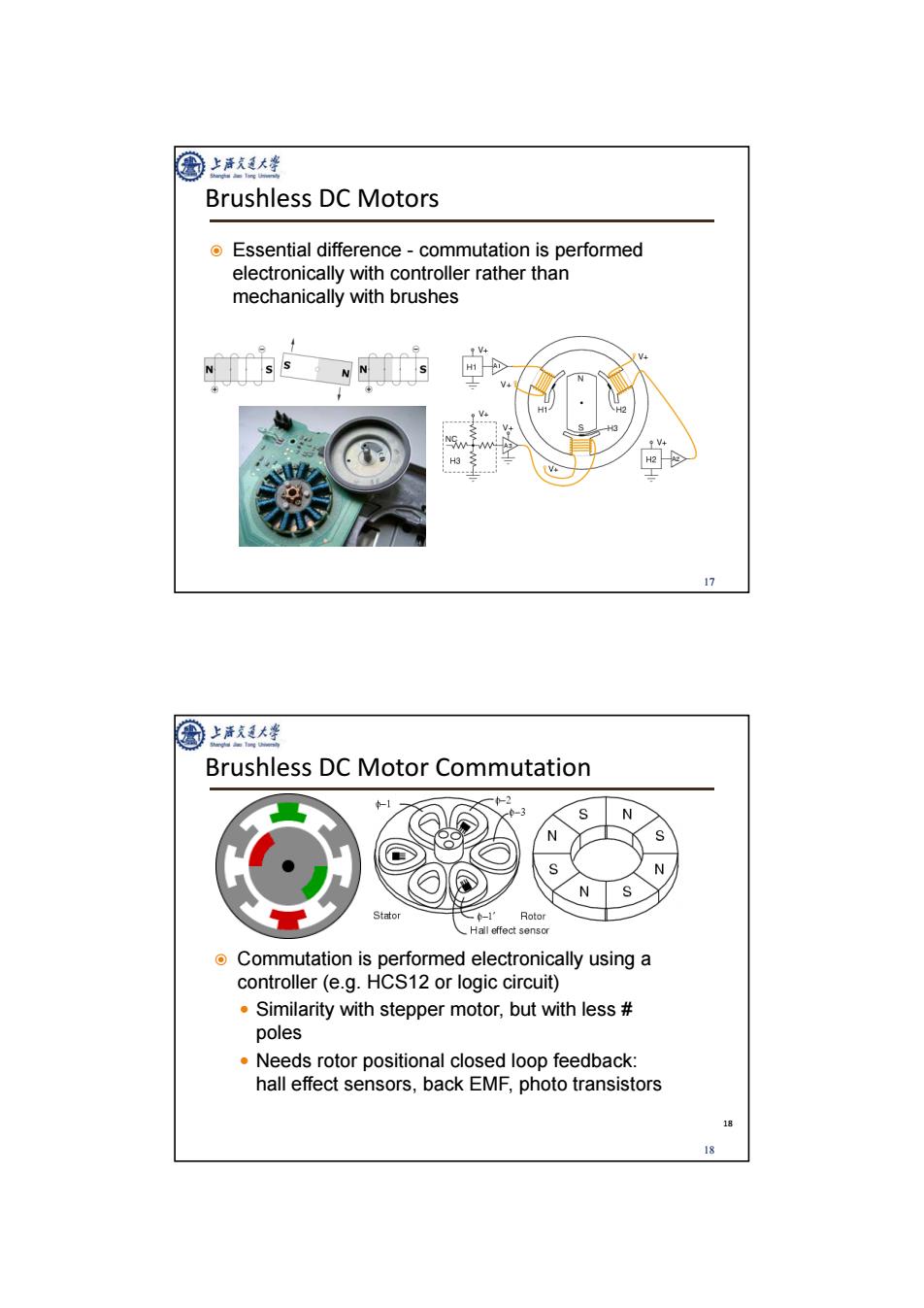
国上活廷大姿 Brushless DC Motors Essential difference-commutation is performed electronically with controller rather than mechanically with brushes ws H * 17 国我人峰 Brushless DC Motor Commutation N N Rotor Hall effect sensor Commutation is performed electronically using a controller(e.g.HCS12 or logic circuit) Similarity with stepper motor,but with less poles Needs rotor positional closed loop feedback: hall effect sensors,back EMF,photo transistors 18 18
17 Brushless DC Motors Essential difference - commutation is performed electronically with controller rather than mechanically with brushes 18 18 Brushless DC Motor Commutation Commutation is performed electronically using a controller (e.g. HCS12 or logic circuit) Similarity with stepper motor, but with less # poles Needs rotor positional closed loop feedback: hall effect sensors, back EMF, photo transistors
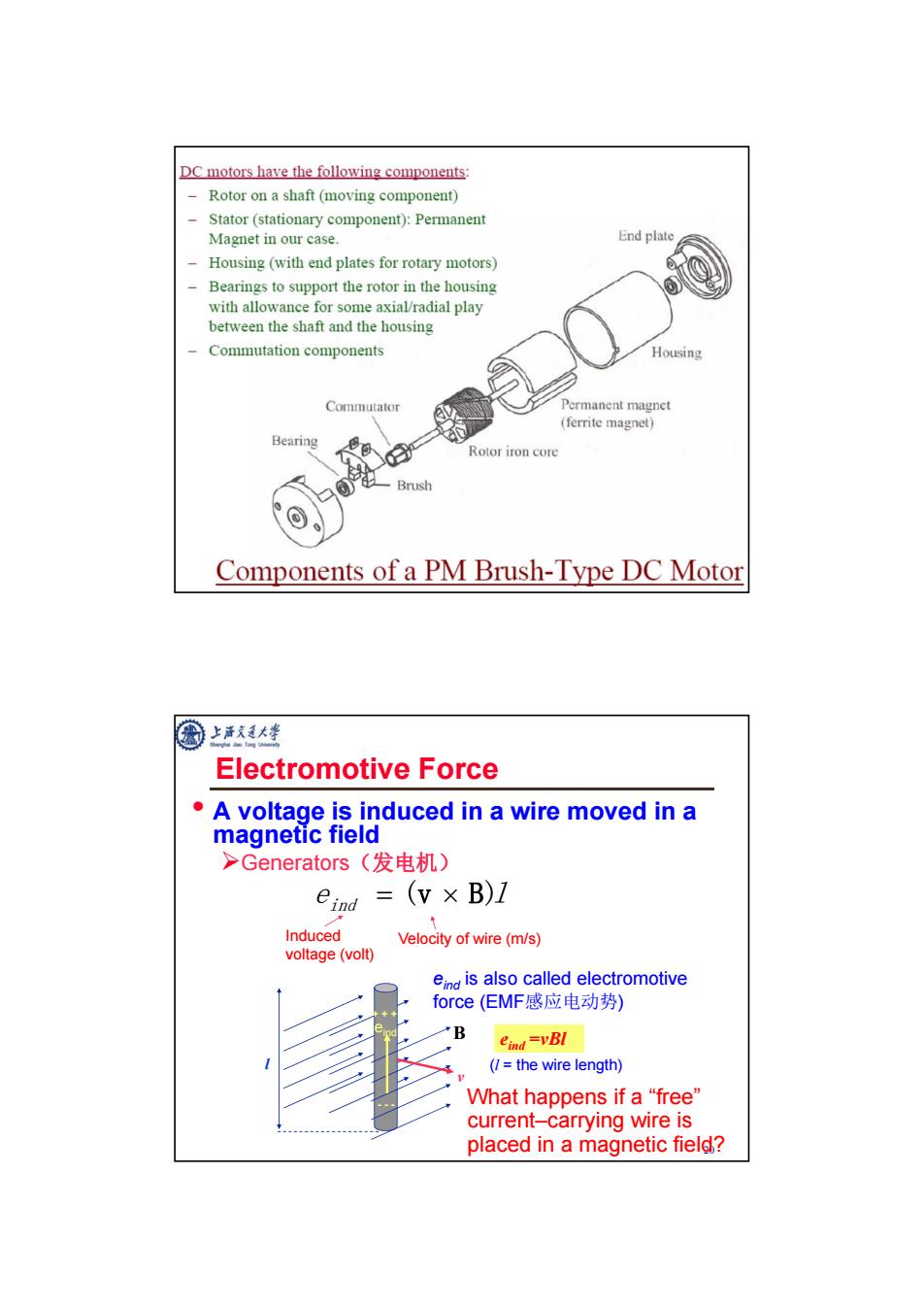
DC motors have the following components: Rotor on a shaft(moving component) Stator(stationary component):Permanent Magnet in our case. End plate Housing (with end plates for rotary motors) Bearings to support the rotor in the housing with allowance for some axial/radial play between the shaft and the housing Commutation components Housing Commutator Permanent magnet (ferrite magnet) Bearing Rotor iron core Brush Components of a PM Brush-Type DC Motor 圈活大娃 Electromotive Force A voltage is induced in a wire moved in a magnetic field >Generators(发电机) eind =(v×B)1 Induced Velocity of wire(m/s) voltage (volt) eind is also called electromotive force(EMF感应电动势) B eind=vBI (/the wire length) What happens if a "free" current-carrying wire is placed in a magnetic field?
19 20 • A voltage is induced in a wire moved in a magnetic field Generators(发电机) B v (l = the wire length) Induced voltage (volt) Velocity of wire (m/s) l eind =vBl eind is also called electromotive force (EMF感应电动势) + + + --- eind What happens if a “free” current–carrying wire is placed in a magnetic field? Electromotive Force eind (v B)l